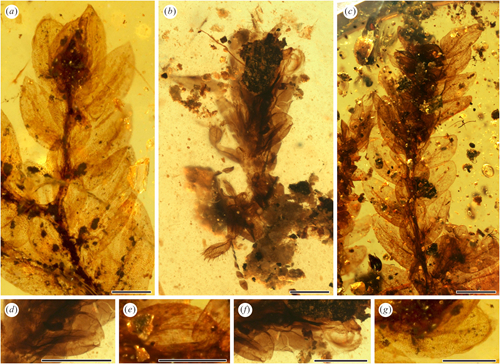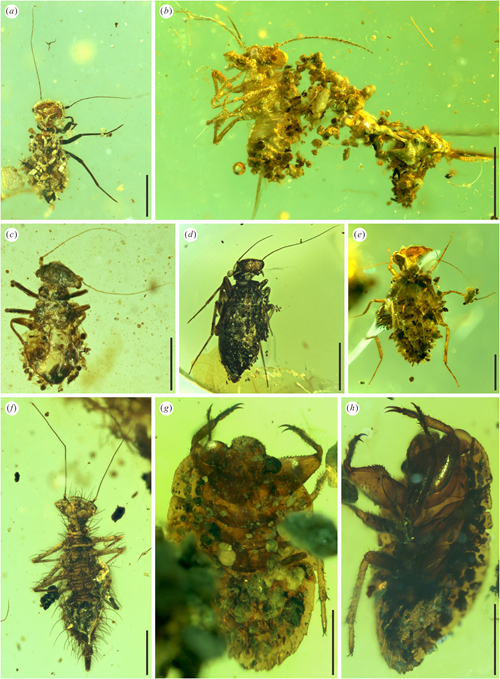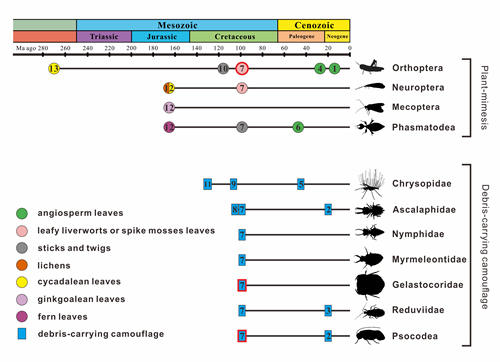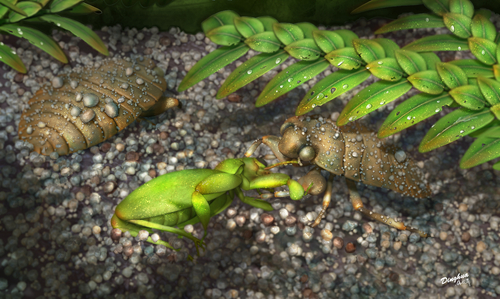How did the camouflage skills of insects originate and evolve? The new reports of mantle behavior in two major groups of insects (the rodent and hemiptera toadstool families) in the Mesozoic advance the record of their mantle behavior to before the great radiation of flowering plants.
Animals have evolved several strategies in prey-predator interactions due to selective pressures, such as mimicry and camouflage. Both mimicry and camouflage enable animals to effectively reduce the probability of detection by prey and predators.
As the most diverse animal group, insects have evolved such strategies through various pathways including utilizing specialized morphologies. Plant-like mimesis and debris-carrying camouflage are rather common adaptations within insects. Plant-like mimesis, an effective way to hide by mimicking leaves, sticks or bark, is rife among resting katydids, walking sticks and leaf insects. Debris-carrying camouflage is most common in Neuroptera and Hemiptera, in which larvae match their life-supporting environment by decorating themselves with exogenous debris.
Although several fossil insects have been reported showing plant-like mimesis and debris-carrying camouflage from the Mesozoic, the abundance of taxa involved is much rarer than in modern groups, and more investigation is needed.
Recently, Mr. XU Chunpeng, supervised by Prof. WANG Bo from Nanjing Institute of Geology and Palaeontology, Chinese Academy of Sciences (NIGPAS), cooperated with researchers from Wuhan University and University of Kansas, have reported a pygmy mole cricket (Tridactylidae) mimicking spike mosses or leafy liverworts from mid-Cretaceous Kachin amber (approximately 99 million years ago). The behavioural mimicry interpretation is further confirmed by Siamese Neural Network analysis. Additionally, the research reported a diverse insect assemblage with debris-carrying camouflage from mid-Cretaceous Kachin amber, comprising six nymphs of Psocodea and a nymph of Gelastocoridae. These researches have been published on Gondwana Research and Historical Biology.
The new find pygmy mole cricket Phyllotridactylus wangi displays mimicry with some coeval spike mosses or leafy liverworts which are spore-bearing plants and quite diverse in mid-Cretaceous Kachin amber. Phyllotridactylus wangi exhibits a morphological resemblance to these leafy liverworts and spike mosses in gross morphology, including the shape of leaves. The most striking feature is the remarkable inflation of the metafemur, which resembles leaf lobes of some spike mosses laterally or dorsolaterally. Additionally, the inflation made by the mesofemur and mesotibia also resembles the central “leaflets” of spike mosses or leafy liverworts. Critically, Mesozoic plant mimesis in Tridactylidae is supported by Siamese Network analysis.
In order to analyze the resemblance of P. wangi with model plants, the researchers developed a new approach to utilize the Siamese Network of Deep Learning, which can measure the dissimilarity between two images by calculating the “distance” between image pairs and provide a dissimilarity value.
The deep learning algorithms are used to quantify the mimicry of fossil insects in this study for the first time, providing a new model for quantifying the mimesis of fossil insects and novel insights into exploring the early evolution of mimicry.
"After pre-training the Siamese Network by part of TLL (a similar image dataset) and fine-tuning it by part of LIMD (a dataset contains image pairs of extant insects and their model mimicry plants), the remainder part of LIMD is input and a dissimilarity threshold value of mimic definition for extant insects is calculated" , Prof. WANG Bo says, "we fine-tuned the dissimilarity threshold value of mimic definition for extant insects based on the FIMD (a dataset contains image pairs of fossil insects and their model mimicry plants), and calculated the dissimilarity threshold value of mimic definition for fossil insects".
Among these specimens, six nymphs of Psocodea and a nymph of Gelastocoridae exhibit debris-carrying behaviour. Psocodean nymphs are belonged to three Morphotypes, which might stick sand and organic material with their setae on their backs. Gelastocorid nymph shows a very flat form, being both dorsally and ventrally covered with unequal-sized sand grains and plant debris. It has a flat abdominal tergum forming a defined space for the trash packet components, which can facilitate carrying debris more stably on the dorsal surface.
These finds are the oldest fossil records of Psocodea and Gelastocoridae with debris-carrying camouflage, extending the geological range of this behaviour within Psocodea and Gelastocoridae by approximately 80 million years. Together with previously known records, these fossils demonstrate that most extant debris-carrying insects (eight groups with direct camouflage) had evolved exogenous camouflage by the mid-Cretaceous.
Mimicry and camouflage are important in insects to avoid detection by both prey and predators. By the Cretaceous, many new predaceous arthropods (including some spiders, lacewing larvae, and ants) and vertebrates (including lizards, birds, and mammals) were present. These results suggest that elaborate mimicry and camouflage were already widespread among insects in the mid-Cretaceous ecosystems during the rise of angiosperms, probably responding to similar selective pressures as those experienced by their extant counterparts.
We thank WANG Ning and GE Chang for kindly providing the specimens, and YANG Dinghua for reconstructions of fossil specimens.
References:
Xu, C., Wang, B., Fan, L., Jarzembowski, E.A., Fang, Y., Wang, H., Li, T., Zhuo, D., Ding, M., Engel, M.S. (2021). Widespread mimicry and camouflage among mid-Cretaceous insects. Gondwana Research. https://doi.org/10.1016/j.gr.2021.07.025.
Fan, L., Xu, C., Jarzembowski, E. A., Cui, X. (2021). Quantifying plant mimesis in fossil insects using deep learning. Historical Biology, 1-10. https://doi.org/10.1080/08912963.2021.1952199.

Figure 1: Pygmy mole cricket Phyllotridactylus wangi gen. et sp. nov. (b, d, f) and potential model plants (a, c, e, g) from mid-Cretaceous Kachin amber.

Figure 2: Psocodean nymphs (a–f) and gelastocorid nymph (g, h) from mid-Cretaceous Kachin amber.

Figure 3: Geological range of insect groups that display plant mimesis and debris-carrying camouflage behaviour.

Figure 4: Ecological reconstruction of gelastocorid nymphs and a tridactylid.
Contact:
LIU Yun, Propagandist
Email: yunliu@nigpas.ac.cn
Nanjing Institute of Geology and Palaeontology, Chinese Academy of Sciences
Nanjing, Jiangsu 210008, China
Download:
